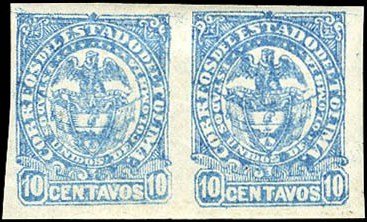Se-tenant: Coat of Arms and long-winged Condor (Colombia 1886)
Coat of Arms and long-winged Condor (Colombia 1886)
01 January (Colombia ) within release TOLIMA: 1886 Definitives goes into circulation Se-tenant Coat of Arms and long-winged Condor face value 2*10 Colombian centavo
| Se-tenant Coat of Arms and long-winged Condor in catalogues | |
|---|---|
| Stamp Number: | Sn: CO-TO 37a |
Se-tenant is square format.
Imperforated pair.Also in the issue TOLIMA: 1886 Definitives:
- Stamp - Coat of arms face value 1;
- Stamp - Coat of arms face value 50;
- Stamp - Coat of Arms and long-winged Condor face value 10;
- Stamp - Coat of Arms and long-winged Condor face value 5;
- Se-tenant - Coat of Arms and short-winged Condor face value 2*2;
- Se-tenant - Coat of Arms and short-winged Condor face value 2*20;
- Se-tenant - Coat of Arms and long-winged Condor face value 2*10;
Se-tenant Coat of Arms and long-winged Condor it reflects the thematic directions:
A coat of arms is an heraldic visual design on an escutcheon (i.e. shield), surcoat, or tabard. The coat of arms on an escutcheon forms the central element of the full heraldic achievement which in its whole consists of shield, supporters, crest, and motto. A coat of arms is traditionally unique to an individual person, family (except in the United Kingdom), state, organisation or corporation.
A vulture is a bird of prey that scavenges on carrion. There are 23 extant species of vulture (including condors). Old World vultures include 16 living species native to Europe, Africa, and Asia; New World vultures are restricted to North and South America and consist of seven identified species, all belonging to the Cathartidae family. A particular characteristic of many vultures is a bald, unfeathered head. This bare skin is thought to keep the head clean when feeding, and also plays an important role in thermoregulation



